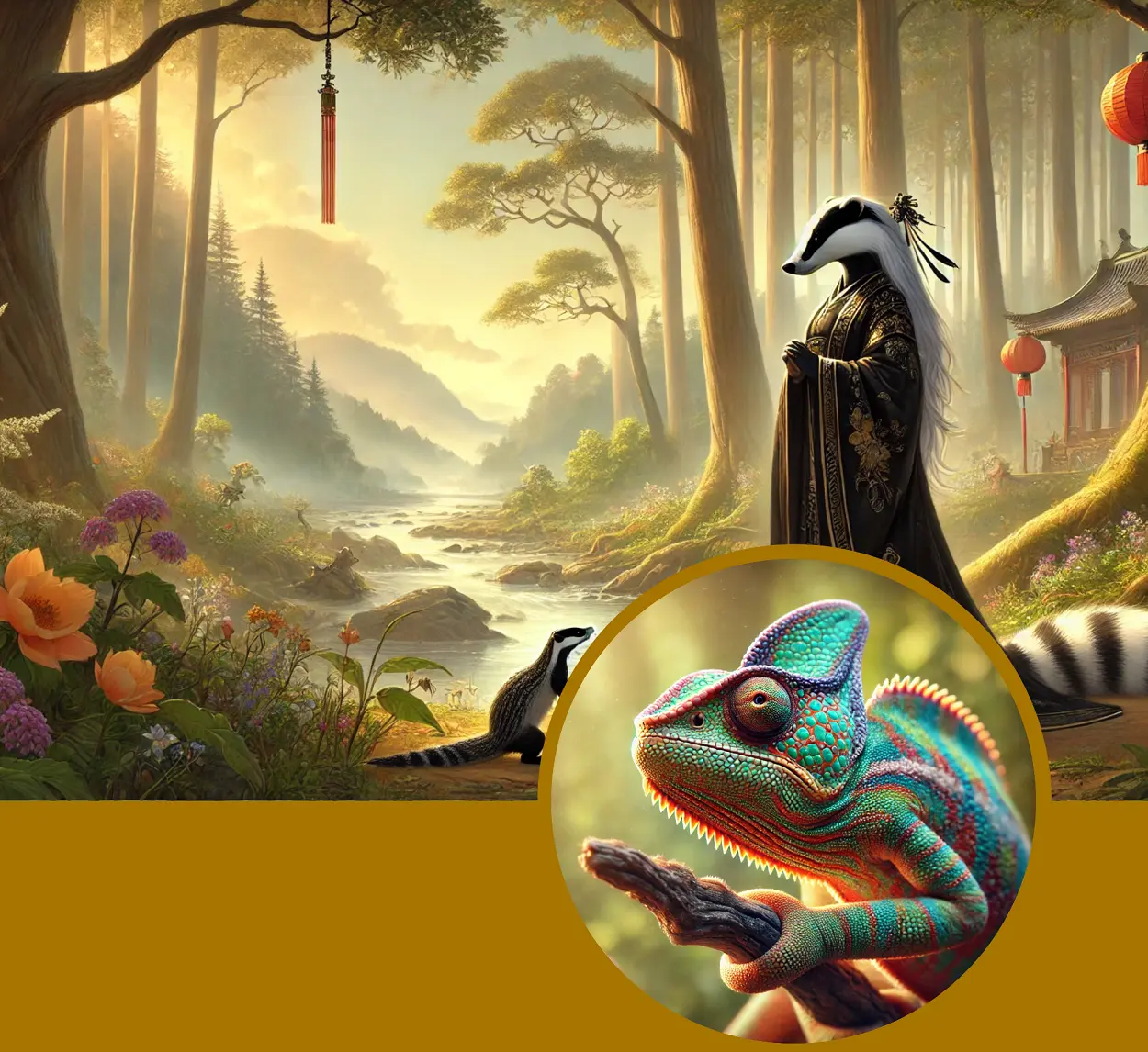Introduction
In this article, we'll delve into the spiritual meaning of the lizard as totemand explores its deep associations with regeneration, adaptability, protection and introspection. This little master of nature inspires us to embrace change, protect what is essential and look inwards for answers. Understanding the symbolic role of the lizard can reveal valuable lessons for living in harmony with our most authentic aspirations, facing life's challenges with courage and resilience.
"The lizard teaches us that true strength lies in the ability to adapt, regenerate and seek within oneself the answers needed to overcome life's challenges." - Anonymous
Index
Spiritual Lessons
If the Lizard has crossed your path, it brings an invitation to dive inside and listen to the voice of your heart. It reminds us that it is essential to question whether we are following our soul's true aspirations or the illusions created by the ego. The ego tends to keep us in patterns of comfort and predictability, but the lizard invites us to dream beyond these barriers, to explore new possibilities and allow our creativity to flourish.
The lizard also suggests that we get away from the distractions of everyday life and go back to dreaming, visualizing what we really want. It is in this process that innovations and changes take place.
If the Lizard is Your Totem
Having the lizard as your totem means that you have a natural ability to move between the physical and spiritual worlds. This ability gives you a deep understanding of situations and a vision beyond the surface. People with the lizard totem tend to be introspective, facing and overcoming their fears throughout their journeys.
These individuals are deeply connected to their intuition and are often able to pick up on details and energies that go unnoticed by others. They bring with them the ability to regenerate emotionally and spiritually, a capacity that strengthens them with every challenge.

Qualities of those who have the Lizard as their Totem
People with the lizard as their totem:
- Resilience and regeneration: Ability to bounce back after challenging experiences.
- IntrospectionEasy to delve into your own feelings and thoughts.
- Spiritual connection: Aptitude for exploring the spiritual world, with strong intuition.
- Self-control and emotional balanceAbility to observe and reflect before acting.
- Courage to face your fears: They face challenges with courage and determination.
Applications in everyday life
The lizard as a totem carries several practical lessons:
- Introspection and self-knowledge: Take the time to understand your true motivations.
- Developing intuitionUse your instinct to make more assertive decisions and avoid risky situations.
- Adaptability: Face changes with flexibility and confidence.
- ResilienceWhen faced with challenges, trust in your ability to regenerate and move forward wisely.
If the Lizard Comes in a Dream
Dreaming of a lizard symbolizes that you have hidden gifts waiting to be explored. It can also be a sign that you have a natural instinct for spotting dangers and acting preventively. Taking advantage of these gifts will help you make wiser choices and protect yourself from traps.
Possible meanings:
- A reminder to trust your intuition and develop spiritual skills.
- Sign to explore hidden gifts that will benefit your growth.
- Message to pay attention to dreams and see what they can reveal about your journey.
Lizard Behavior in the Wild
O lizard is widely known for its adaptability and resistance. Living in a variety of habitats - from deserts and rainforests to urban areas - lizards adjust their behavior according to the conditions of the environment, demonstrating an incredible capacity for adaptation. This adaptability also involves the ability to modify their body temperature, moving to warmer or shadier areas as necessary to regulate their internal heat. This aspect teaches the importance of adjusting to circumstances, a concept that can be applied to challenging situations in our own lives.
A striking feature is its camouflage capability. Lizards like the chameleon have colors and textures that blend in with the environment, helping them to escape predators and approach prey. This behavior is an example of discretion and observation, reinforcing the idea that sometimes it is more advantageous to observe and wait for the right moment before acting. This ability to "hide in plain sight" reminds us of the power to choose when and how we want to be noticed or stay out of the spotlight, depending on what is safest or most appropriate at any given time.
Another fascinating attribute of lizards is their regeneration of body partsespecially the tail. Many lizards are able to shed their tails during a dangerous situation, a tactic that distracts predators while the lizard escapes. Over time, it manages to regenerate this tail, symbolizing the power of renewal and resilience. This ability teaches us the importance of knowing when to give something up in order to survive or grow stronger, as well as reminding us of the incredible ability to start again and heal after losses or challenges.
The lizard's behavior also involves hunting and protection habits. Many lizards have keen eyesight and excellent perception of movement, which allows them to react quickly to threats and search for food efficiently. They are patient and generally cautious hunters. When danger arises, they may remain motionless to blend into the environment or use an evasive approach, which reinforces the importance of acting calmly and strategically in risky situations.
In short, the lizard's behavior in the wild is a profound example of how the qualities of adaptation, regeneration and camouflage can inspire us to face challenges. It reminds us of the importance of resilience, the ability to adjust to the environment and to look for the right moment to act. These attributes symbolize the wisdom that the lizard shares, demonstrating that it is possible to be strong and resilient even in difficult circumstances, adapting with subtlety and persistence.

Curiosities about the Lizard
- Regeneration: One of the most impressive abilities of lizards is regeneration. When threatened, many lizards can lose their tails to distract predators and, over time, regenerate this part of their body. This phenomenon not only protects the lizard, but also symbolizes the power of renewal and healing. The ability to regenerate reminds us of the ability to start over and rebuild ourselves after challenging situations, showing that healing is a natural and continuous process.
- Cultural Symbology: The lizard is considered a messenger between worlds in many ancient cultures. For the Mayans and Aztecs, it symbolized creation and vital energy, an intermediary between the spiritual and material realms. In Australian Aboriginal culture, it is seen as a guardian of ancestral wisdom, associated with the earth and the eternal cycle of life and death. In indigenous spirituality, the lizard also represents the ability to adapt and the importance of dreaming in order to manifest realities, being seen as a guide who brings hidden messages about one's deepest desires.
- Camouflage and Adaptation: The lizard is a master at camouflaging itself in the environment, changing color and remaining motionless to avoid detection by predators. This ability to adapt is one of its most remarkable and teaches it the value of discretion and patience. Through camouflage, it teaches us that in some situations it is wiser to watch and wait than to act impulsively, also symbolizing the ability to adapt to changing environments and circumstances in order to survive and thrive.
Call to Action
If the lizard crosses his path, he calls it to him:
- Examining your inner world and your dreams. Ask yourself what you really want for yourself.
- Explore your intuition and use it to avoid traps.
- Connecting with your hidden gifts and apply them to your own benefit and that of others.
Conclusion
The lizard as a totem is a master of self-knowledge and regeneration. By teaching us to explore our dreams and trust our intuition, it reminds us that true strength comes from within. May the lizard's lessons inspire courage to face challenges, wisdom to listen to our intuition and resilience to start again whenever necessary.
I'm passionate about magic and spirituality, always looking for new knowledge about rituals, energies and the mystical universe. Here, I share magical practices and spiritual tips for those who want to connect more deeply with themselves and the world around them, all in a light and accessible way.








